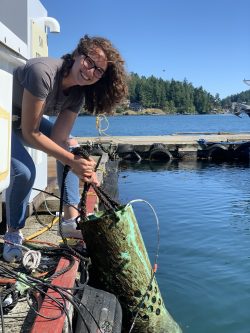Friday Harbor Laboratories (FHL) recently established the Friday Harbor Laboratories Ocean Observatory (FHLOO), vastly expanding their capabilities to collect and share real-time data about the surrounding marine environment. Connected to the larger Northwest Association of Networked Ocean Observing Systems (NANOOS), FHLOO takes continuous seawater measurements such as salinity, temperature, CO2, oxygen and chlorophyll, in addition to monitoring microplankton. While the system has been taking measurements since the summer of 2020, the ability to live-stream its data is new, providing a window into the Salish Sea accessible to researchers, students and the public.

“FHLOO is the only live-streaming asset of its kind in the San Juan Archipelago, so I like to think of it as a digital ‘lighthouse’ for marine scientists,” says postdoctoral researcher Kirk Sato. “Until the FHLOO was installed, FHL only monitored for water temperature and salinity. Using programming and code, we’ve been able to translate incoming raw bits of data from multiple sensors and package all the data into a single file, which is what you can see on the NANOOS NVS Data Explorer site.”
FHL is unique because of its physical location, which is not quite in the open ocean but not quite in Puget Sound proper, either. Influenced by the Fraser River and Strait of Juan de Fuca, there is significant freshwater and saltwater tidal mixing due to currents and reef formations throughout the archipelago. FHLOO will collect data over the long term, allowing scientists to better understand the dynamics of this marine ecosystem.
So, what is this new system measuring exactly and why?
FHLOO quantifies chlorophyll in the water, which gives researchers information about the phytoplankton present. Phytoplankton are microscopic marine algae that play a critical role at the base of the food web and are crucial for energy flow in the ocean. Using an instrument called the Imaging FlowCytoBot (IFCB), biological oceanographers like Evelyn Lessard can study the abundance and diversity of phytoplankton, shedding light on which species are prevalent at certain times and how changes in the environment might affect them.

“We still have little understanding how the multiple stressors brought on by ocean change, like ocean acidification, warming and pollution, may be affecting phytoplankton and the food webs they support,” Lessard explains. “This data will also make possible the development of an automated harmful algal bloom (HAB) alert system to provide timely alerts for Sound Toxins, and tribal, state and federal resource managers in the region.”
FHLOO also provides fundamental measurements that inform scientists about the impacts of ocean acidification. The system is now part of the Global Ocean Acidification Observing Network, a network of scientists who observe the status of ocean acidification and its effects across the globe. With the release of the latest Intergovernmental Panel on Climate Change report, it’s clear that ocean observing systems are more relevant and necessary than ever to determine how the ocean responds to a changing climate.
“Water is habitat, just like the forest and rocky intertidal, and it’s important to study how climate change affects these waters. Events like marine heat waves and summer droughts affect the temperature and salinity of these waters,” says UW principal oceanographer Jan Newton. “Having the high-resolution FHLOO data allows us to see these influences and to assess how they may affect marine resources. We can look at the area over different time scales, such as changes between day and night, between seasons or interannually to see long-term trends.”
Other scientists and students can reap the benefits from the observing system as well. For example, biologists studying crab populations now have real-time data about habitat conditions and no longer have to make assumptions when experimenting in the lab. Additionally, the constant stream of data can inform forecasting models about conditions in the marine environment and provide early warning of changes looming for researchers, managers and industry. For example, temperature and pH are important for shellfish growing operations, and a forecasting tool can help determine if environmental parameters are favorable for shellfish crops. Such capabilities allow for early action to mitigate negative effects.
This system is also a boon for students, such as those in Newton’s Pelagic Ecosystem Function research apprenticeship, allowing them to develop more accurate analyses over a short period of time. As the database grows, the chance to analyze data over time and compare to prior years will too.
“Friday Harbor Labs is one of many working marine research and education facilities around the world, and one of many organizations on San Juan Island that cares deeply about conservation and sustainability,” says Sato. “We want to share what we learn within the vast network to understand how global climate change is affecting local marine life. It’s the power of partnership!”
Thanks to funding from the National Science Foundation and a collaboration of efforts between the University of Washington College of the Environment, Friday Harbor Laboratories, School of Oceanography, Applied Physics Laboratory, NANOOS and the Department of Biology, FHLOO is currently up and live streaming with open-source data. The data are gathered and processed in the context of similar observation and forecast data gathered by NANOOS, which serves the Pacific Northwest. All of the data are archived and available in the national Biological and Chemical Oceanography Data Management Office at NSF. If you are a user of FHLOO, researchers are looking for feedback to continuously strengthen the system.

